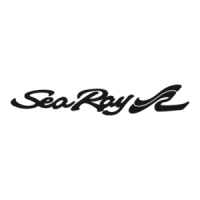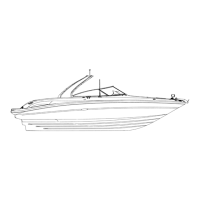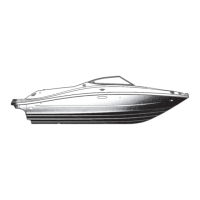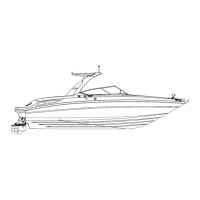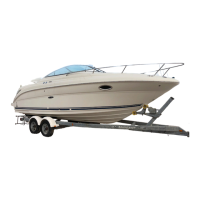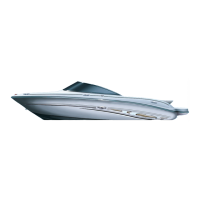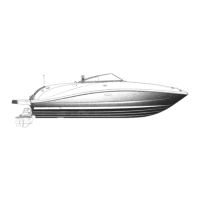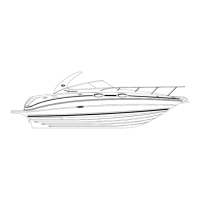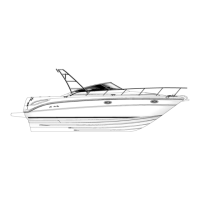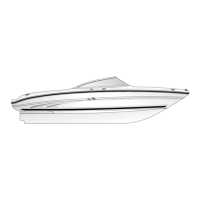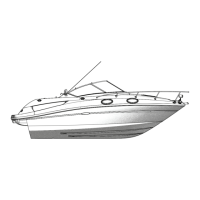Do you have a question about the Sea Ray 250 Select EX and is the answer not in the manual?
Describes the manual's content, including safety, features, use, and maintenance.
Operator's duties for safety, including courses, handling, rules, and registration.
Lists organizations and resources for boating courses and information.
Dealer's duties, including predelivery checks, demonstrations, and providing manuals.
Explains warranty coverage for boat components and systems.
Location and importance of the HIN for correspondence and orders.
Sea Ray's compliance with safety acts and industry standards like ABYC and ISO.
Guidance on obtaining service, parts, and repair from authorized dealers.
Advises on safety precautions and label locations, replacement, and meanings.
Lists USCG minimum required safety equipment for boats 26' to 40'.
Details requirements and procedures for fire extinguishers and fire fighting.
Explains CO hazards, symptoms, and prevention methods.
Covers PFD types, requirements, and proper use for safety.
Lists recommended items beyond legally mandated equipment for safe boating.
Warns against operating a boat under the influence of drugs or alcohol.
Discusses passenger and cargo limits for safe operation.
Advice on engine selection and modifications affecting boat handling.
Guidance on selecting and maintaining propellers for optimal performance.
Explains factors affecting boat stability and risk of capsizing.
Emphasizes operator awareness of surroundings and safe maneuvering.
Discusses boat design categories and safety precautions in different weather conditions.
Importance of planning routes, using charts, and notifying others of your plans.
Safety guidelines for swimming, skiing, and diving activities.
Procedures for medical emergencies, water rescue, fire, flooding, collisions, grounding, and system failure.
Provides contact information for safety resources and information.
Lists international standards and specifications for vessel construction.
Addresses regulations and warnings regarding fuel/oil spillage and waste disposal.
Glossary of common boating terms and definitions.
Explains the meaning of various symbols used on controls and in the manual.
Illustrates the placement and types of warning labels on the boat.
Guidance on proper methods for docking, lifting, and storing the boat.
Advises on safe passenger positions and preparation for boat movement.
Provides key physical dimensions and clearance specifications for the boat.
Diagram and labels showing the arrangement of deck features and components.
Details the helm controls, gauges, and switch panel layout.
Identifies the function and placement of various through-hull fittings.
Explains the stern drive propulsion system and its components.
Details major boat controls including shift, throttle, trim tabs, and power trim.
Explains important gauges like SmartCraft, tachometer, oil pressure, and compass.
Requirements and operation of navigation and anchor lights.
Critical pre-use checks for boat operation, safety, and departure.
Detailed procedures and safety precautions for refueling the boat.
Guidelines for safe boarding, including load distribution and gear stowage.
Instructions on PFD use, requirements, and accessibility for passengers.
Operator's role in instructing passengers on boat behavior and safe seating.
Pre-start checks, procedures, and safety warnings for starting the engine.
How to shift gears and operate the boat smoothly and safely.
Procedure for safely stopping the engine after operation.
Information on the steering system, its maintenance, and potential failures.
Covers bilge maintenance, fuel/oil spills, drain plug, pump, and blower.
Discusses engine maintenance, vibration, stern drive impact, and propeller selection/installation.
General information on propellers, including characteristics and cavitation.
Diagram illustrating the layout of bilge components and systems.
Details the fuel system components including tank, vent, valve, and supply line.
Essential safety precautions for static electricity, general fueling, and checklists.
Covers batteries, maintenance, charging, and cable routing.
Importance of ignition-protected components to prevent sparks in gasoline environments.
Location, types, and replacement guidelines for fuses.
Information on the 12-volt accessory outlets for powering devices.
Details on boat lighting fixtures and bulb replacement.
Information on the 120V/60Hz and 220V/50Hz AC wiring systems.
Description of the main distribution panel and its breakers.
Procedures for connecting, disconnecting, and maintaining shore power.
Guidance on replacing components on the main distribution panel.
Information on the automatic battery charging unit.
Explanation of GFI receptacle function and safety benefits.
How to prevent corrosion using zinc anodes and their maintenance.
Description of the Mercathode system for stern drive protection.
Reference to electrical schematics and diagrams for service.
Guides to locating and identifying key equipment and accessories on the boat.
Covers water system operation, sanitizing, pump/filter, and winterizing.
Operation of the fresh water washdown sprayer.
System for managing grey water discharge in restricted areas.
Overview of available toilet systems, their operation, and holding tank management.
Information on the 12-volt stereo system and its operation.
Operation of remote controls on the steering wheel for stereo and display.
Use and safety precautions for the optional water sport tower.
Use of the fire extinguisher discharge port in case of fire.
Operation and indicator light for the automatic fire suppression system.
Information about the optional refrigerator and its fuse protection.
Safety warnings and installation tips for canvas covers.
Operation and fuse protection for the boat horn.
Operation and fuse protection for the optional spot light.
Operation and fuse protection for optional docking lights.
Operation of the Corsa™ Thru-Hull Exhaust System for sound and performance.
Chart summarizing inspection and service intervals for boat systems.
Blank fields for recording owner, boat, engine, and dealer information.
Detailed procedures for inspecting bilge, engine, fuel system, wiring, and fittings.
Checks for fuel system, batteries, and miscellaneous items after storage.
Tips for securing the boat, including removing keys and electronics.
Checklists for boarding, departing, underway, returning, securing, and engine start issues.
Checklist for verifying seaworthiness and condition of added equipment.
Template for recording maintenance performed on the boat.
Guidance on selecting safe cleaning agents and avoiding hazardous ones.
Instructions for washing, waxing, and maintaining fiberglass and gelcoat surfaces.
Methods for removing stains and scratches from boat surfaces.
Methods to prevent marine growth on hulls of moored boats.
Tips for maintaining bottom paint and inspecting for repainting.
Cleaning and maintenance of stainless steel, alloy fittings, and salt crystals.
Care instructions for gauge and switch panels.
Cleaning and care guidelines for acrylic plastic surfaces.
Proper cleaning, storage, and care for canvas and vinyl components.
Cleaning and care instructions for exterior upholstery fabrics.
